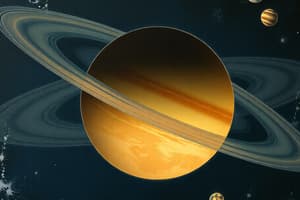Podcast
Questions and Answers
किरणीय ग्रहांच्या चक्रधारा एका उत्तराधिकारात ठरेल कोणतं काय?
किरणीय ग्रहांच्या चक्रधारा एका उत्तराधिकारात ठरेल कोणतं काय?
- पृथ्वी हे सूर्याकडे पूर्ण वृत्तात संपलं असतं
- सूर्याच्या दोन प्रकारच्या बिंदूंत पृथ्वी आणि ग्रह होतात
- पृथ्वीवरून हे ग्रह कोणत्या मिश्रितत्वात सूर्याकडे चक्रधारा करतात (correct)
- ग्रह मिश्रितत्वात सूर्याच्या चक्रधारेला सुसंघताने व्यापलेलं असतं
किरणीय ग्रहांचा सम भूमिकेतील फरक कसं म्हणून समजलं जाऊ शकतं?
किरणीय ग्रहांचा सम भूमिकेतील फरक कसं म्हणून समजलं जाऊ शकतं?
- पृथ्वीने सूर्याकडे कोनत्या क्षेत्रासमोर प्रकट होणारी आकृती सम केली
- पृथ्वीने सूर्यापेक्षा परिमित क्षेत्र सम समयानुसार पॅथ पुरस्कृत केलं (correct)
- सूर्यापेक्षा अपेक्षित दूरीपेक्षा पृथ्वीने समसंवेग सुरुकेलं
- सूर्याकडे कोनत्या क्षेत्रात जुना कोनता पुनरावृत्ती होतो, ते सम
'कलकिरणी' मिश्रितत्व प्रमाणे कसं म्हणलं जाऊ शकतं?
'कलकिरणी' मिश्रितत्व प्रमाणे कसं म्हणलं जाऊ शकतं?
- पृथ्वीने सूर्य कोलकीत मोकळी केलेलं
- सुरुकेलं, मिश्रितत्व
- मुक्त समसंख्यक क्षेत्र, सम समय
- सम समयानुसार पुनरावृत्त होणारं समसंख्यक क्षेत्र (correct)
'कलकिरणी' सम मिश्रितत्व प्रमाणे कसं म्हणलं जाऊ शकतं?
'कलकिरणी' सम मिश्रितत्व प्रमाणे कसं म्हणलं जाऊ शकतं?
What did ancient Greeks like Aristotle and Ptolemy observe about celestial bodies?
What did ancient Greeks like Aristotle and Ptolemy observe about celestial bodies?
Who published the laws of motion and universal gravitation in the 17th century?
Who published the laws of motion and universal gravitation in the 17th century?
What does Newton's third law of motion state about gravitating bodies?
What does Newton's third law of motion state about gravitating bodies?
In the equation for gravitational force \[F = \frac{G \times m_1 \times m_2}{r^2}\], what does 'r' represent?
In the equation for gravitational force \[F = \frac{G \times m_1 \times m_2}{r^2}\], what does 'r' represent?
According to Einstein's theory of general relativity, why do we perceive gravitation as a force?
According to Einstein's theory of general relativity, why do we perceive gravitation as a force?
What was confirmed by the LIGO collaboration in 2015?
What was confirmed by the LIGO collaboration in 2015?
What is the Pioneer anomaly mentioned in the text?
What is the Pioneer anomaly mentioned in the text?
How has our understanding of gravitation benefited space exploration?
How has our understanding of gravitation benefited space exploration?
What is one of the ongoing challenges in modern physics related to gravitation?
What is one of the ongoing challenges in modern physics related to gravitation?
How has our understanding of gravitation contributed to the development of GPS technology?
How has our understanding of gravitation contributed to the development of GPS technology?
Flashcards
Kepler's First Law (Law of Orbits)
Kepler's First Law (Law of Orbits)
Planets orbit the Sun in an ellipse, with the Sun at one focus.
Kepler's Second Law (Law of Equal Areas)
Kepler's Second Law (Law of Equal Areas)
A planet sweeps out equal areas in equal times.
Kepler's Third Law (Law of Periodic Times)
Kepler's Third Law (Law of Periodic Times)
The square of a planet's orbital period is proportional to the cube of its average distance from the Sun.
Who was Tycho Brahe?
Who was Tycho Brahe?
Signup and view all the flashcards
Heliocentric Model
Heliocentric Model
Signup and view all the flashcards
Geocentric Model
Geocentric Model
Signup and view all the flashcards
Universal Law of Gravitation
Universal Law of Gravitation
Signup and view all the flashcards
General Relativity
General Relativity
Signup and view all the flashcards
What does 'r' represent in Kepler's Third Law?
What does 'r' represent in Kepler's Third Law?
Signup and view all the flashcards
What does 'T' represent in Kepler's Third Law?
What does 'T' represent in Kepler's Third Law?
Signup and view all the flashcards
Study Notes
Unraveling Kepler's Secrets of Planetary Motion
Nearly 400 years ago, Johannes Kepler laid the groundwork for our modern understanding of the complex dance of celestial bodies, particularly planets orbiting the Sun. His laws of planetary motion, which revolutionized astronomical thinking, stemmed from his meticulous analysis of data collected by Tycho Brahe, the Danish astronomer.
The Three Laws
-
Law of Orbits: Planetary orbits are ellipses with the Sun at one of the two foci. This means that planets do not orbit the Sun in perfect circles but rather in elliptical paths, with the Sun remaining at one of the two points where the paths intersect.
-
Law of Equal Areas: Planets sweep out equal areas in the plane of their orbit in equal intervals of time. In simple terms, this means that a planet covers the same amount of ground on its orbit in the same amount of time, regardless of its distance from the Sun.
-
Law of Periodic Times: The squares of the periods of revolutions of the planets are directly proportional to the cubes of their mean distances from the Sun. Mathematically, this can be expressed as:
[T^2 = k \times r^3]
where (T) is the period of the orbit, (r) is the average distance between the planet and the Sun, and (k) is a constant.
These laws, which are now central tenets of astronomy, were instrumental in establishing a foundation for the heliocentric model of our solar system, challenging the prevailing geocentric view.
Kepler's Influence
Kepler's laws opened the door to a wealth of future discoveries, including the universal law of gravitation by Sir Isaac Newton and the mathematical modeling of planetary systems by Pierre-Simon Laplace. The laws also laid the groundwork for Einstein's theory of general relativity, which extended these principles to include gravitational curvature of spacetime.
Today, Kepler's laws are a testament to the power of observation, experimentation, and theoretical reasoning in advancing our understanding of the universe. They continue to guide astronomers and astrophysicists as they seek to understand the origins and dynamics of planetary systems around stars like our Sun.
Studying That Suits You
Use AI to generate personalized quizzes and flashcards to suit your learning preferences.



